|
|
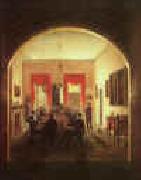 |
Henry Sargent -- Click Here
|
|
1770-1845
Henry Sargent Gallery
Henry Sargent (baptized November 25, 1770 ?? February 21, 1845), American painter and military man, was born in Gloucester, Massachusetts. One of seven children born to Daniel and Mary (Turner) Sargent and the brother of Lucius Manlius Sargent, he was a great-grandson of William Sargent, who received a grant of land at Gloucester in 1678. His father was a prosperous and public-spirited merchant. Henry was sent as a young boy to Dummer Academy, South Byfield, and then, the family having moved to Boston, he continued his studies under local teachers. After a period in the counting house of Thomas Handasyd Perkins, he continued his commercial apprenticeship with his father, but suddenly, as he was attaining his majority, without having previously shown special partiality for the arts of design, he determined to become an artist. An elder brother's efforts in this direction seem to have stimulated him, and his mother encouraged him. John Trumbull, who visited Boston in 1790, saw some of his work and found it promising.
In 1793 Sargent went to London, where he studied with Benjamin West and had courteous treatment from John Singleton Copley. A letter of Sargent's dated March 27, 1795 shows that he found living in London expensive and the painter's profession much depressed. He returned to Boston in 1799, still strongly conscious of "the apathy then existing towards the arts". Accordingly, in that same year he took a commission in the national army then being raised under the command of Alexander Hamilton. This service was brief, but it gave Sargent a taste for military life which motivated his long connection with the Massachusetts militia. In or shortly after 1799 he joined the Boston Light Infantry, which had been organized the year before and of which his brother, Daniel Sargent, was captain. Records of the adjutant-general's office in the Massachusetts State House show that Henry Sargent became first lieutenant of this company on October 1, 1804, and captain on March 31, 1807. Of a tall, thin, Yankee build, he was a handsome officer and an efficient drill master. During the War of 1812 his company aided in the fortification of Fort Strong, and on May 31, 1815, he was appointed aide-de-camp to the governor, with the rank of colonel. In 1812, 1815, 1816, and 1817 he was a member of the Massachusetts Senate.
On April 2, 1807, Sargent married Hannah, the daughter of Samuel and Isabella (Pratt) Welles, of Boston, and they had two daughters who died in infancy and two sons, one of whom was Henry Winthrop Sargent.
In the course of the following decade, growing deafness caused him gradually to withdraw from public services and to devote himself entirely to his painting and to mechanical inventions; he achieved no particular fame in the latter field. His painting was that of a diligent and gifted artist whose talent fell short of genius. His portraits were less masterful than those of his fellow townsman, Gilbert Stuart, with whom he was personally intimate. Like Copley, whom he somewhat resembled as a painter, Sargent enjoyed intensive elaboration of textures and accessories. He had a capacity for doing canvases that required sustained effort. The well-known Landing of the Pilgrims, at Pilgrim Hall, Plymouth, attributed to him, is not representative of his best work. Far better are the two conversation pieces, The Dinner Party (ca. 1821) and The Tea Party (ca. 1824), owned by the Museum of Fine Arts, Boston. These have something of the exquisiteness of the so-called Little Dutchmen and they give fascinating glimpses of social life in Boston homes of the early 19th century. An altar painting, The Christ Crucified, which Sargent made for the Holy Cross Church, Boston, won contemporary favor. The full-length portrait of Peter Faneuil, in Faneuil Hall, if by Sargent, to whom it is ascribed, must be a copy after John Smibert. Sargent's self-portrait is at the Museum of Fine Arts; his likenesses of Jeremy Belknap, D.D., and John Clarke, D.D., both friends of his parents, are at the Massachusetts Historical Society. Continuing to paint at intervals down into old age, he was elected in 1840 an honorary member of the National Academy of Design and in 1845, president of the newly-organized Artists' Association of Boston. |
|
|
|
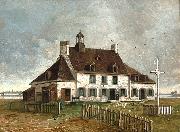 |
Henry Richard S. Bunnett -- Click Here
|
|
1845 -1910
David Ross McCord (1844-1930) commissioned Henry Richard S. Bunnett (1845-1910) to paint over 200 oil paintings between 1885 and 1889. The works depicted buildings, views and places around Quebec that McCord felt were of historical importance. |
|
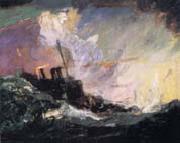 |
Henry Reuterdahl -- Click Here
|
|
American, 1871-1925
He was best known for his paintings of Navy warships and recruiting posters for World War |
|
 |
Henry Redmore -- Click Here
|
|
Henry Redmore was born in Hull in 1820. He lived his whole life in the North East of England, with his studio in Hull. Along with John Ward, Redmore was one of the best painters of the Hull School, although the two artists had distinctly different techniques |
|
|
|
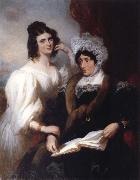 |
Henry Perronet Briggs -- Click Here
|
|
British Painter, ca.1791-1844 |
|
|
|
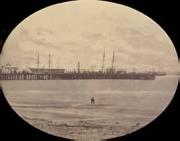 |
Henry P.Moore -- Click Here
|
|
American artist 19 century
|
|
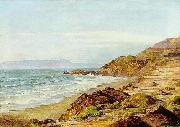 |
Henry Otto Wix -- Click Here
|
|
Henry Otto Wix (1866 - 1922), also known as Otto Wix, was a German-born landscape and portrait painter who emigrated to the United States in the late 1890s. He studied in New York, but visited Hawaii in 1907 and 1908-9. About 1910, he moved to San Francisco, but visited Hawaii again in 1912. He also made several sketching trips to Mexico. Wixes marriage ended in divorce, resulting in depression and alcoholism. He died by his own hand in Santa Barbara, California on March 13, 1922.
Wix is best known for his landscapes in watercolor. The Honolulu Academy of Arts and the Smithsonian American Art Museum are among the public collections holding paintings by Henry Otto Wix |
|
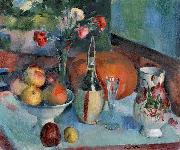 |
Henry Ottmann -- Click Here
|
|
painted Nature morte aux fruits et a la fiasque de vin in 20th century
French, 1877-1927 |
|
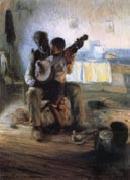 |
Henry Ossawa Tanner -- Click Here
|
|
African-American Realist Painter, 1859-1937
American painter. He was one of the foremost African American artists, achieving an international reputation in the early years of the 20th century for his religious paintings. The son of an African Methodist Episcopal bishop, he studied art with Thomas Eakins from 1880 to 1882 at the Pennsylvania Academy of the Fine Arts in Philadelphia. He then worked in Philadelphia and Atlanta, GA, where he ran a photography studio and taught at Clark College. |
|
 |
Henry nelson o neil,A.R.A. -- Click Here
|
|
1817-1880
|
|
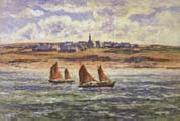 |
Henry Moret -- Click Here
|
|
French Impressionist Painter, 1856-1913 |
|
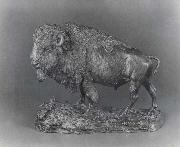 |
Henry Merwin Shrady -- Click Here
|
|
American Sculptor, 1871-1922,was the sculptor of the Ulysses S. Grant Memorial in Washington, D.C. Shrady was born in New York City. His father, George Shrady, was one of the physicians who attended former president Ulysses S. Grant during the struggle with throat cancer that led to his death on July 23, 1885. Shrady graduated from Columbia University in 1894 and spent one year thereafter at Columbia's law school. He left law school to join with his brother-in-law, Jay Gould (son of millionaire Edwin Gould, the financier), at the Continental Match Company. The company failed and Shrady contracted typhoid fever which diverted him forever from the business world. His recuperation left spare time to pursue a growing interest in art. Shrady's wife, Harrie Moore, submitted some of his paintings to an exhibition of the National Academy of Design without his knowledge and they sold quickly. He then began to teach himself sculpture using zoo animals and his pets as models. Shrady and architect William Casey Pearce won the competition to build the Ulysses S. Grant Memorial in 1902. In the twelve years Shrady spent executing the memorial, he studied biology at the American Museum of Natural History and dissected horses to gain a better understanding of animal anatomy. |
|
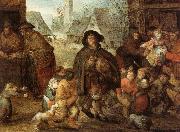 |
henry mayhew -- Click Here
|
|
English journalist and sociologist. He studied law but soon turned to journalism. In 1841 he founded the highly successful Punch. A vivid and voluminous writer, he is best known for London Labour and the London Poor (1851 C 62), an evocation of the sights and sounds of the working-class districts of London, which influenced Charles Dickens and other writers. He also wrote plays, farces, fairy tales, and novels, some in collaboration with his brother Augustus Septimus Mayhew |
|
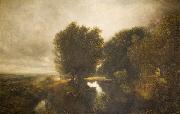 |
Henry Mark Anthony -- Click Here
|
|
(4 August 1817 - 1 December 1886) was an English landscape artist, often favourably compared to John Constable by critics. He exhibited at many major art institutions and travelled widely, being credited with introducing the en plein air style of painting to Britain.
|
|
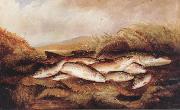 |
Henry Leonidas Rolfe -- Click Here
|
|
British,active 1847-81 |
|
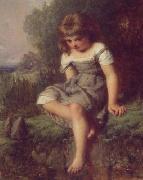 |
Henry Lejeune -- Click Here
|
|
(12 December 1819 - 5 October 1904) was an English painter of landscapes, genre, literary and biblical scenes. He became well-known for his genre paintings of children.
Henry Le Jeune was born in London, the son of Anthony Le Jeune, a professional musician of Flemish origin, and the third of five children. After showing an early interest in art he was encouraged by his family to study the art collections in the British Museum.
In 1834 Le Jeune was admitted to the Royal Academy where, after winning 4 silver medals in succession, he won a gold medal in 1841 for the biblical painting "Samson Bursting his Bonds". He first exhibited at the Royal Academy in 1840 with a work entitled "Joseph Interpreting the Dream of Pharaoh's Chief Butler".
From 1845-48 he taught at the Government School of design at Somerset House, and from 1848-64 was curator and instructor at the Royal Academy. He was elected an Associate of the Royal Academy (ARA) in 1863 and an honorary retired associate in 1886.
Le Jeune married Dorothy Lewis (1815-1864) on 21 June 1844 and had five sons and three daughters. He lived in London all his life, dying in Hampstead in 1904. |
|
|
|
 |
Henry John Yeend King -- Click Here
|
|
an important Victorian genre and landscape artist . English,1855-1924
|
|
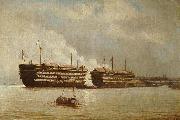 |
Henry J. Morgan -- Click Here
|
|
painted HMS 'Excellent' and HMS 'Illustrious' by Henry J. Morgan in 1860s |
|
 |
Henry J Morgan -- Click Here
|
|
painted HMS 'Comus' in 1899 |
|
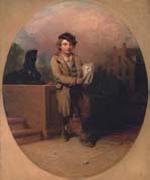 |
Henry Inman -- Click Here
|
|
American Painter, 1801-1846,was an American portrait, genre, and landscape painter.He was born at Utica, N. Y., October 20, 1801, and was for seven years an apprentice pupil of John Wesley Jarvis in New York City. He was the first vice president of the National Academy of Design. He excelled in portrait painting, but was less careful in genre pictures. Among his landscapes are "Rydal Falls, England," "October Afternoon," and "Ruins of Brambletye." His genre subjects include "Rip Van Winkle," "The News Boy," and "Boyhood of Washington;" his portraits, those of Henry Rutgers and Fitz-Greene Halleck in the New York Historical Society, of Bishop White, Chief Justices Marshall and Nelson, Jacob Barker, William Wirt, Audubon, DeWitt Clinton, Martin Van Buren, and William H. Seward. |
|
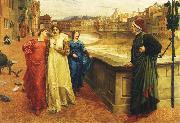 |
Henry Holiday -- Click Here
|
|
Henry Holiday (17 June 1839 - 15 April 1927) was an English historical genre and landscape painter, stained glass designer, illustrator and sculptor. He is considered to be a member of the Pre-Raphaelite school of art.
|
|
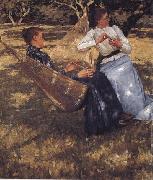 |
Henry Herbert La Thangue -- Click Here
|
|
British painter , 1850-1920 |
|
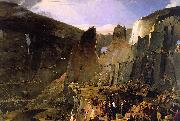 |
Henry Hawkins -- Click Here
|
|
British, died 1881
was an English judge.
Born at Hitchin, he was the son of a solicitor, and was early familiarized with legal principles. He received his education at Bedford school, and was called to the bar at the Middle Temple in 1843. He at once joined the old home circuit, and after enjoying a lucrative practice as a junior, became a barrister in 1859. His name is identified with many of the famous trials of the reign of Queen Victoria. He was engaged in the Simon Bernard case (of the Orsini plot celebrity), in that of Roupell v. Waite, and in the Overend-Gurney prosecutions. The two cause celbres, however, in which Hawkins attained his highest legal distinction were the Tichborne trials and the great will case of Sugden v. Lord St. Leonards. In both of these he won. |
|
|
|
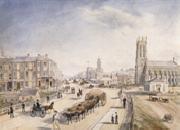 |
Henry Gritten -- Click Here
|
|
Australian Landscape artist
1818-1873
was an English/Australian artist. Gritten was the son of a London picture dealer, was born probably in 1817. He studied art and was on friendly terms with David Roberts and other leading artists of the period. He began exhibiting at the Royal Academy in 1835, and during the next 10 years 12 of his pictures were hung at its exhibitions. He was a more frequent exhibitor at the British Institution, and had 30 of his pictures hung there between 1836 and 1848. In the latter year he went to the United States and in about 1852 arrived in Australia. He went first to the Bendigo goldfields, but soon resumed painting in Victoria and Tasmania; there is a View of Hobart in 1857 by him at the National Library of Australia at Canberra. He was represented at the first exhibition of the Victorian Academy of Art held at Melbourne in 1870. He died suddenly at Melbourne leaving a widow and four children in poor circumstances. Gritten was quite a capable painter of his period who had a hard struggle in Australia. |
|
|
|
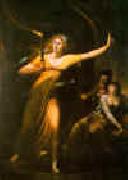 |
Henry Fuseli -- Click Here
|
|
Swiss-born British Romantic Painter, 1741-1825
Henry Fuseli was the first artist to command the epic literature and heroic history of northern Europe as well as the Mediterranean countries, and by his wide reading and close study of the Old Masters he equipped himself to extend the scope of history painting far beyond the traditional limits of the Bible and classical antiquity. In his speculative boldness he was a child of the Enlightenment, but he was also a fierce critic of sterile rationalism and preached the gospel of the imagination with religious fervor.
Henry Fuseli was born Johann Heinrich F??ssli (in 1764 he Anglicized his name) in Zurich on Feb. 6, 1741, the son of a painter with strong religious convictions who destined him for the Zwinglian ministry. After a period of intensive theological study Fuseli was ordained in 1761 and preached his first sermon. He was a friend of Johann Kaspar Lavater, whose Aphorisms on Man he later translated into English from manuscript. Fuseli became the favorite disciple of Johann Jakob Bodmer, who in 1740 had published an essay on the wonderful in poetry that led to a literary war with Johann Christoph Gottsched in Germany and the formation of a revolutionary Swiss school which used English literature, especially Milton and Shakespeare, as a spearhead in promoting romanticism. |
|
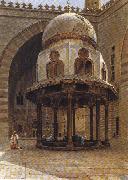 |
Henry Ferguson -- Click Here
|
|
American, 1842 - 1911 |
|
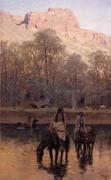 |
Henry F. Farny -- Click Here
|
|
French-born American Painter and Printmaker, 1847-1916 |
|
|
|
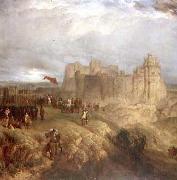 |
Henry Dawson -- Click Here
|
|
a landscape painter, was born in Hull in 1811, but came with his parents to Nottingham when an infant, so that he always regarded the latter as his native town. His parents were poor, and he began life in a Nottingham lace factory. But even while engaged in lace-making he continued to find time for art, and used to paint small pictures, which he sold at first for about half-a-crown each. In 1835 he gave up the lace trade and set up as an artist, his earliest patron being a hairdresser in Nottingham, who possessed a taste for art. In 1844 he removed to Liverpool, where after a time he got into greater repute, and received higher prices for his works. In 1849 he came with his family to London, and settled at Croydon, where some of his best pictures were painted. Among these may be reckoned 'The Wooden Walls of Old England,' exhibited at the British Institution in 1853, 'The Rainbow,' 'The Rainbow at Sea,' 'London Bridge,' and ' London at Sunrise.'
With the exception of six lessons from Pyne received in 1838, Henry Dawson was entirely a self-taught artist, and his art shows much originality and careful realism. He studied nature for himself, but he seems in later life to have been moved by Turner's influence to try more brilliant effects than he had before dared. Many of his works indeed are very Turneresque in treatment, though he can scarcely be called an imitator of Turner, for he had a distinct style of his own.
Henry Dawson, though painting much, and selling his pictures for high prices in his later life, remained, strange to say, very little known except to artists and connoisseurs until the large and very interesting collection of his works that was made for the Nottingham Exhibition in 1878 brought him wider fame. This exhibition showed him to be a genuine English landscape painter, of no great imaginative or intellectual power, but who delighted in nature, and represented her faithfully to the best of his ability. He died in December 1878, at Chiswick, where he had for some time resided.
|
|
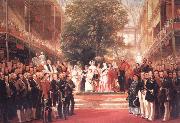 |
Henry Courtnay Selous -- Click Here
|
|
(1803-1890), Painter and lithographer |
|
|
|
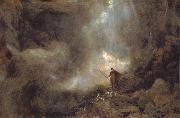 |
Henry Clarence Whaite -- Click Here
|
|
British artist, 1828-1912 |
|
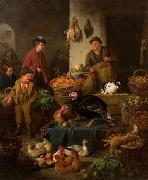 |
Henry Charles Bryant -- Click Here
|
|
(1835 - 1915) was a popular painter of portraits and landscapes specialising in farmyard and market scenes which were noted for their great attention to detail. He worked mainly in London and exhibited frequently between 1860 and 1880 at the Royal Academy, the British Institution and the Royal Society of British Artists. His paintings are highly sought after today.He died at 49, Derby Road, Portsmouth in January, 1915(Obituary:- Hampshire Telegraph & Post, January 8, 1915).
|
|
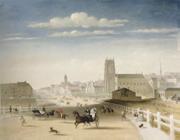 |
Henry Burn -- Click Here
|
|
British Painter and Engraver
1807-1884 |
|
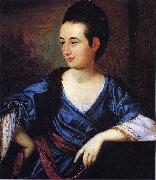 |
Henry Benbridge -- Click Here
|
|
Henry Benbridge born October 1743 died February 1812), early American portrait painter, was born in Philadelphia, the only child of James and Mary (Clark) Benbridge. When he was seven years old, his mother, who had been left a widow, was married to Thomas Gordon, a wealthy Scot. The boy's artistic talent was encouraged. He made decorative designs for his stepfather's drawing-room which were much admired. When he was fourteen years old he may have watched John Wollaston paint Gordon's portrait. It has been plausibly argued that young Benbridge had instruction from Wollaston, since his earliest known portrait, that of his half-sister Rebecca Gordon, "seems to hark back to Wollaston." When he was 21, Benbridge was sent to Italy, where he studied with Pompeo Batoni and Anton Raphael Mengs. In 1769, on commission from James Boswell, biographer of Dr. Samuel Johnson, he made a portrait of Pasquale Paoli in Corsica which he took to London. It was exhibited (1769) at the Free Society of Artists, and from it three mezzotints were scraped and published with the artist's name signed "Bembridge." Like other young Americans he was encouraged by Benjamin West. He wrote, on December 7, 1769, to his stepfather: "Upon my arrival I waited upon Mr. West who received me with a sort of brotherly affection, as did my cousin, Mrs. West." Impelled, apparently, by a longing to rejoin his family, he left England in 1770, bearing from West the following note of recommendation to Francis Hopkinson: "By Mr. Benbridge you will receive these few lines. You will find him an Ingenous artist and an agreeable Companion. His merit in the art must procure him great incouragement and much esteem. I deare say it will give you great pleasure to have an ingenous artist resident amongst you."
Elizabeth Ann Timothy (Mrs. William Williamson), watercolor on ivory of 1775In Philadelphia Benbridge married a Miss Sage and was admitted on January 18, 1771, to membership in the American Philosophical Society, of which Benjamin Franklin was a founder. He painted the large portrait of the Gordon family, with six figures, one of his masterpieces. Suffering, however, from asthma, he sought a more congenial climate and moved to Charleston, South Carolina, where he succeeded Jeremiah Theus (d. May 18, 1774) as the popular portrait painter of South Carolina. There he made many likenesses of southern men and women, several of which have been popularly attributed to John Singleton Copley, an artist who never painted in the South and who left America in 1774. Around 1800 Benbridge settled in Norfolk, Virginia, whence he made frequent visits to his native city. At Norfolk he gave to Thomas Sully his first lessons in oil painting. He had previously instructed Thomas Coram of Charleston. Sully describes his master as "a portly man of good address - gentlemanly in his deportment." Benbridge's health is said by Hart to have declined in middle age. Dunlap's assertion that his last years were passed "in obscurity and poverty" has been disputed. |
|
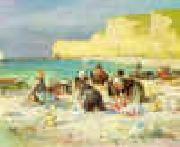 |
Henry Bacon -- Click Here
|
|
1839-1922
Henry Bacon Gallery
Henry Bacon was born in Watseka, Illinois to father civil engineer Henry Bacon and mother Elizabeth Kelton Bacon, both of Massachusetts. Bacon was largely raised in Wilmington, N.C., where his father settled down and served as a government engineer in charge of the Cape Fear River improvements. At age 15, Henry Bacon was sent north to Boston's Chauncey Hall School. In 1884 he matriculated at the University of Illinois at Urbana-Champaign, but left within a year to launch an architectural career in the office of Chamberlin & Whidden in Boston as a draftsman. Bacon was soon hired into the office of famed McKim, Mead & White in New York City, the best-known American architectural firm of its time.
While at McKim, Mead & White (MMW), Bacon won, in 1889, the Rotch Traveling Scholarship for architectural students, which gave him two years of study and travel in Europe, learning and drawing details of Roman and Greek architecture as far afield as Turkey, where he met his future wife, Laura Florence Calvert, daughter of a British Consul. He traveled with another fellowship student, Albert Kahn who would become a leading industrial architect. Returning to the U.S. he spent a few more years with his mentor, McKim, working on projects like the Rhode Island State House in Providence, Rhode Island, and serving as McKim's personal representative in Chicago during the World's Fair in Chicago, where MMW was at work designing certain buildings for the World's Fair.
In 1897, Bacon left the office of McKim, Mead & White (MMW) to found, with a younger MMW architect James Brite, a new partnership Brite and Bacon Architects, where Brite was in charge of financial, administrative, and contracting aspects of the partnership, while Henry Bacon was in charge of the architectural design and construction. The partnership immediately won the competition for the Jersey City Public Library, the Hall of History for the American University at Washington, DC, and thereafter built a good number of public buildings and a small number of private residences. The partnership was selected to build two private residences in 1897, the "La Fetra Mansion" in Summit, New Jersey, and a three-story Georgian mansion "Laurel Hill" in Columbia, NC. The "La Fetra Mansion" was completed by the partnership sometime during 1899 to 1900, and published in the September 1901 issue of The Architecture, the pre-eminent architectural professional journal of its time. The LeFetra Mansion fully exhibits Bacon's Greek and Roman architectural predilections, his simple, austere, elegant lines, and his skill in dimensions and proportions that give rise to a feeling of the presence of divine spirituality, peaceful tranquility, and a sense of divine protection. While the La Fetra Mansion in Summit, NJ bears Bacon's signature style, the Georgian Mansion "Laurel Hill" was most probably designed by Brite. |
|
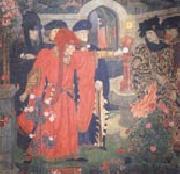 |
Henry Arthur Payne -- Click Here
|
|
British Architect , 1868-1940 |
|
|
|
|
|
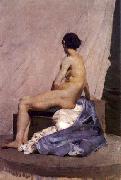 |
Henrique Pousao -- Click Here
|
|
Henrique Cear de Arauo Pousa (Vila Vicsa, 1 January 1859 - Vila Vicsa, 20 March 1884) was a Portuguese painter.
|
|
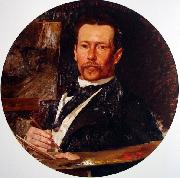 |
Henrique Bernardelli -- Click Here
|
|
painted Portrait of the painter Pedro Weingartner in 1858 - 1936 |
|
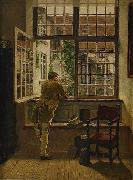 |
Henrik Nordenberg -- Click Here
|
|
painted Interior with a boy at a window in 1857-1928 |
|
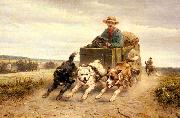 |
Henriette Ronner-Knip -- Click Here
|
|
was a Dutch painter.
Born Henriëtte Knip in Amsterdam, she moved at a young age to Den Bosch and was until 1850 active in Sint-Michielsgestel and Boxtel. That year she married Feico Ronner and moved to Belgium, first to Brussels and in 1878 to Elsene. She studied with her father, Joseph August Knip.
She was best known for her paintings of subjects from nature, especially cats and dogs.
|
|
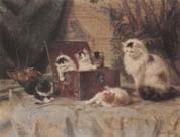 |
Henriette Ronner -- Click Here
|
|
French
1821-1909
He was a Dutch painter. Born Henriette Knip in Amsterdam, she moved at a young age to Den Bosch and was until 1850 active in Sint-Michielsgestel and Boxtel. That year she married Feico Ronner and moved to Belgium, first to Brussels and in 1878 to Elsene. She was best known for her paintings of subjects from nature, especially cats and dogs. |
|
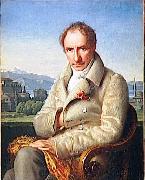 |
Henriette Lorimier -- Click Here
|
|
(7 August 1775, Paris - 1 April 1854) was a popular portraitist in Paris at the beginning of Romanticism.
She lived with the French diplomat and philhellene writer Francois Pouqueville (1770-1838).
student of the history painter Jean-Baptiste Regnault, she soon exhibited fine portraits and genre paintings at the Paris' Salons from 1800 to 1806 and from 1810 to 1814.
In 1805 Princess Caroline Murat-Bonaparte, a sister of the Emperor, purchased "La Chevre Nourriciere" a painting exhibited at the 1804 Salon and in 1806 Henriette Lorimier was awarded a First Class Medal for her painting of "Jeanne de Navarre" which was then purchased by the Empress Josephine de Beauharnais, consort of the Emperor Napoleon Ier. |
|
|
|
 |
Henrietta Rae -- Click Here
|
|
(30 December 1859 - 26 January 1928) was a prominent English painter of the later Victorian era.
Born in Hammersmith, London, she was the youngest of seven children of a civil servant; her mother was musically talented, a former student of Felix Mendelssohn. An uncle, Charles Rae, was an artist and a student of George Cruikshank. Rae began studying art at age thirteen; she was educated at the Queen Square School of Art, Heatherley's School of Art (she was its first female pupil), and the British Museum. She reportedly had to apply to the Royal Academy schools at least five times before she was accepted though she eventually gained a seven-year scholarship. Her teachers there included Frank Bernard Dicksee, William Powell Frith, and Sir Lawrence Alma-Tadema; the last of these had the strongest influence on Rae's later work. She became a frequent exhibitor at the annual Royal Academy shows, beginning in 1881.
She gained recognition and success early in her career, specializing in classical, allegorical, and literary subjects, often treated in a grand style and scale; her Psyche at the Throne of Venus (1894) measured 12 feet by 7 feet (305 by 193 cm) and contained 13 figures. Other paintings in the same classical vein include her Ariadne (1885), Eurydice (1886), Zephyrus and Flora (1888), Apollo and Daphne (1895), Diana and Calisto (1899), and Hylas and the Water Nymphs (1910) among many more. |
|
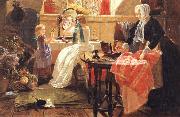 |
Henrietta Mary Ada Ward -- Click Here
|
|
Historical genre painter.1852-1924
|
|
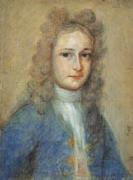 |
Henrietta Johnston -- Click Here
|
|
b.born before 1670, probably Ireland buried March 7, 1729,
was an early American pastellist. Born Henrietta Deering, probably in Ireland, she married in 1705 and emigrated to America in 1707, settling in Charles Towne (now Charleston, South Carolina). A total of 40 pastel portraits by Johnston are known, dating from 1707 to around 1725. After her husband's death in 1716, Johnston was forced to support herself and her children, becoming possibly the first professional female painter in America. She's a very talented artist. |
|
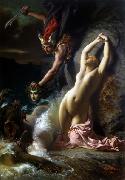 |
Henri-Pierre Picou -- Click Here
|
|
(27 February 1824 - 17 July 1895) was a French painter born in Nantes.His oeuvre began with portraits and classical historical subject matter but he later moved on to allegorical and mythological themes.He was an academic painter and one of the founders of the Neo-Grec school, along with his close friends Gustave Boulanger, Jean-L??on G??rôme, and Jean-Louis Hamon, also academic painters. All of them studied in the workshops of both Paul Delaroche and later Charles Gleyre. Picou's style was noticeably influenced by Gleyre. While the rest of the group generally painted classical and mythological subjects, Picou also received commissions for large religious frescoes from many churches, including the Église Saint-Roch.
His artistic debut was at the Salon in 1847. The next year he was awarded a second-class medal for his painting, Cl??opâtre et Antoine sur le Cydnus. Also known as Cleopatra on the Cydnus, it is commonly regarded as Picou's masterpiece. This showing at the Salon in 1848 was written about by the critic Th??ophile Gautier, who felt that the subject matter was too ambitious, but also said that "As it is, it gives the best hope for the future of the young artist, and ranks among the seven or eight most important paintings of the Salon.In 1875 the painting was exhibited in New York, and afterward found lodgment on the walls of a private art gallery in San Francisco.Picou maintained a large workshop in Paris on the Boulevard de Magenta, which provided him room to work on his expansive frescoes. His popularity continued to rise and he went on to win the Second Prix de Rome in 1853 for his painting, J??sus chassant les vendeurs du Temple (The Moneylenders Chased from the Temple), and another second-class medal for his Salon painting in 1857. From his debut in 1847, he was a regular at the Salon, showing almost every year until his final exhibit in 1893.He has been called the most fashionable painter towards the close of the Second French Empire |
|
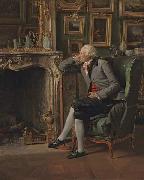 |
Henri-Pierre Danloux -- Click Here
|
|
(February 24, 1753 - January 3, 1809) was a French painter and draftsman.
He was born in Paris. Brought up by his architect uncle, Danloux was a pupil of Lepicie and later of Vien, whom he followed to Rome in 1775. In 1783, he returned to Lyon and Paris, where he was patroned by the Baronne Megret de Serilly d'Etigny, who secured for him a number of important portrait commissions. He emigrated to London in 1792 during the French Revolution and returned to Paris in 1801. Danloux was influenced by fashionable English portrait painters such as Thomas Lawrence (1769-1830), John Hoppner (1758-1810), and George Romney (1734-1802). In 1793, he exhibited at the Royal Academy in London which resulted in commissions from a number of British patrons. Danloux returned to Paris in 1801, and died there in 1809. |
|
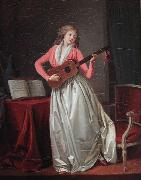 |
Henri-Nicolas Van Gorp -- Click Here
|
|
painted Nina chantant la romance in |
|
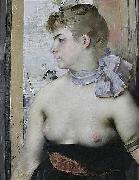 |
Henri-Lucien Doucet -- Click Here
|
|
(1856-1895) was a French figure and portrait painter, born in Paris, where he studied under Lefebvre and Boulanger, and in 1880 won the Prix de Rome. His pictures are usually piquant, sparkling representations of modern life, eminently Parisian in style, but the audacious realism of his earlier work is not maintained in his later, which is somewhat characterless. His portraits in pastel are also notable.
His most widely known picture is Apres le bal (After the Ball, 1889). Other excellent examples are the portraits of Celestine Galli-Marie as Carmen (1884, Marseille Museum), La princesse Mathilde Laetitia Wilhelmine Bonaparte and My Parents (1890, Lyons Museum), A Spanish Woman (Pontoise Museum), and Nude Figure (1890). He was awarded a first-class medal for pastel in 1889 and the Legion of Honour in 1891.
His painting A Skating Party, of 1893, was exhibited at the Chicago World Fair or the World's Columbian Exposition, which was held from May to October 1893 in Chicago in honour of the 400th anniversary of Columbus' discovery of the New World. Goupil made a limited edition first impression photogravure of the painting. |
|
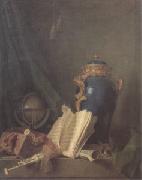 |
Henri-Horace Roland de La Porte -- Click Here
|
|
Paris 1724-1793
French painter. He was a pupil of Jean-Baptiste Oudry and was approved by the Academie Royale de Peinture et de Sculpture in 1761 as a 'painter of animals and fruit'. He presented his morceau de reception, the ambitious Vase of Lapis, Ornamented with Bronze and Placed near a Globe (Paris, Louvre), in 1763. This large painting is reminiscent of Oudry's work and depicts a collection of sumptuous objects against a simple cloth backdrop. Roland de la Porte's later works are much more intimate in scale and approach and depict simple rustic objects in a restrained yet realistic fashion in a manner akin to Chardin, for whose works his own have been mistaken. The Still-life with Bread and Fruit (Rotterdam, Boymans-van Beuningen) is bathed in a warm light; the composition is unusual in that the bread, plums and preserve pot are represented at the viewer's eye level, obscuring the top of the table. The Little Orange Tree (Karlsruhe, Staatl. Ksthalle) uses several devices similar to those used by Chardin: a light source comes from the upper left-hand side, throwing some of the surfaces into relief and highlighting them against the indistinct background; a single straw is brought into focus and seems to protrude out of the picture |
|
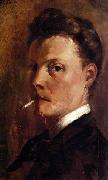 |
Henri-Edmond Cross -- Click Here
|
|
(May 20, 1856 - May 16, 1910) was a French pointillist painter.
Cross was born in Douai and grew up in Lille. He studied at the École des Beaux-Arts. His early works, portraits and still lifes, were in the dark colors of realism, but after meeting with Claude Monet in 1883, he painted in the brighter colors of Impressionism. In 1884, Cross co-founded the Societe des Artistes Independants with Georges Seurat. He went on to become one of the principal exponents of Neo-Impressionism. He began his Pointillist period after spending time with Paul Signac in 1904. His later works are Fauvist, perhaps influenced by his acquaintance with Henri Matisse.
His final years, plagued by rheumatism, were spent in Saint-Clair[disambiguation needed ], where he died in 1910. His pieces include The Church of Santa Maria degli Angely Near Assisi (1909) and Landscape with Stars.
The Allen Memorial Art Museum (Oberlin College, Ohio), the Block Museum of Art (Northwestern University, Illinois), The Art Institute of Chicago, the Fine Arts Museums of San Francisco, Harvard University Art Museums, the Hermitage Museum, the Honolulu Academy of Arts, Kröller-Meller Museum, the Los Angeles County Museum of Art, the Metropolitan Museum of Art, Museum of Grenoble (Grenoble, France), Musee d'Orsay (Paris), Musee Malraux (Le Havre, France), Musee Richard Anacreon (Granville, France), the Museum of Modern Art (New York City), the National Gallery of Art (Washington D.C.), New Art Gallery (Walsall, England), the Tel Aviv Museum of Art and the Thyssen-Bornemisza Museum (Madrid), are among the public collections holding works by Henri-Edmond Cross.
|
|
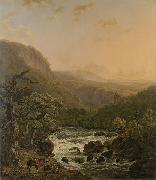 |
Henri van Assche -- Click Here
|
|
born at Brussels in 1774, showed from his earliest years a predilection for painting, and received from his father, who was a distinguished amateur artist, the first principles of design and perspective. He was afterwards placed with Deroy of Brussels, from whom he received further instructions in painting. Journeys in Switzerland and Italy contributed to develop his talent as a landscape painter. His great partiality for representing waterfalls, mountain streams, and mills gained for him the name of 'The Painter of Waterfalls.' Several pictures by him may be seen in public and private collections of Brussels, Ghent, Lille, and Haarlem, some of which are enriched with figures and animals by Ommeganck. He died at Brussels in 1841.
|
|
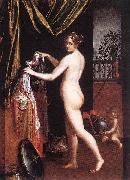 |
Henri Testelin -- Click Here
|
|
(Paris, 1616 - The Hague, 1695) was a French art painter.
Henri Testelin made portraits of Louis XIV, important persons and events at the French court . Several of his paintings can be seen in the palace of Versailles. The portraits, like the one of the young Louis XIV, show the influence of Jean Nocret and Le Brun.
He was secretary of Royal Academy of Painting and Sculpture from 1650 and professor from 1656. In 1680 he published a book on art theory and the academy. Testelin was dismissed from the Academy in 1681, because he was proptestant. He left France and went to Holland.
|
|
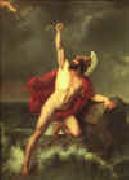 |
Henri Serrur -- Click Here
|
|
1794-1865
French
Henri Serrur Gallery |
|
|
|
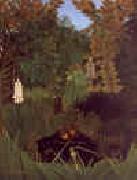 |
Henri Rousseau -- Click Here
|
|
French
1844-1910
Henri Rousseau Locations
He was born in Laval in the Loire Valley into the family of a plumber. He attended Laval High School as a day student and then as a boarder, after his father became a debtor and his parents had to leave the town upon the seizure of their house. He was mediocre in some subjects at the high school but won prizes for drawing and music. He worked for a lawyer and studied law, but "attempted a small perjury and sought refuge in the army," serving for four years, starting in 1863. With his father's death, Rousseau moved to Paris in 1868 to support his widowed mother as a government employee. In 1871, he was promoted to the toll collector's office in Paris as a tax collector. He started painting seriously in his early forties, and by age 49 he retired from his job to work on his art. His wife died in 1888 and he later remarried.
Rousseau claimed he had "no teacher other than nature", although he admitted he had received "some advice" from two established Academic painters, Felix Auguste-Clement and Jean-Leon Gerome. Essentially he was self-taught and is considered to be a naive or primitive painter. |
|
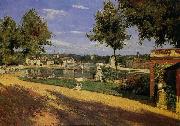 |
Henri Rouart -- Click Here
|
|
France (1833 -1912 ) - Painter
|
|
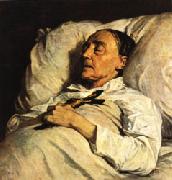 |
Henri Regnault -- Click Here
|
|
Paris 1843 - Buzenval 1871.
French Academic Painter, 1843-1871. Studied under Alexandre Cabanel. Specializes in Orientalism. Painter, son of Victor Regnault. He showed exceptional abilities as a draughtsman from an early age. After a traditional classical education he was sent in 1860 to the Ecole des Beaux-Arts, Paris, where he studied with Louis Lamothe (1822-69) and Alexandre Cabanel. In 1866 he won the Prix de Rome competition with Thetis Giving the Weapons of Vulcan to Achilles (Paris, Ecole N. Sup. B.-A.). In Italy he began several other ambitious history paintings, including Automedon Taming the Horses of Achilles |
|
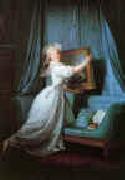 |
Henri Pierre Danloux -- Click Here
|
|
1753-1809 French
French painter and draughtsman. He was orphaned at an early age and was brought up by an uncle who was an architect and contractor. Around 1770 his uncle apprenticed him to Nicolas-Bernard Lpici. He exhibited for the first time in 1771 at the Exposition de la Jeunesse in Paris, where he showed a Drunkard at a Table (untraced). About 1773 he was admitted into the studio of Joseph-Marie Vien, whom he followed to Rome in 1775 on the latter appointment as Director of the Academie de France. Danloux sketchbooks show that he also travelled to Naples, Palermo, Florence and Venice. He was not interested in the monuments of antiquity but concentrated instead on drawing landscapes and, in particular, portraits, among them that of Jacques-Louis David. |
|
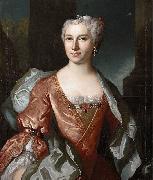 |
Henri Millot -- Click Here
|
|
(1699 -1756 ) - Painter
|
|
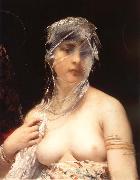 |
Henri Lucien Doucet -- Click Here
|
|
France
1856-1895
was a French figure and portrait painter, born in Paris, where he studied under Lefebvre and Boulanger, and in 1880 won the Prix de Rome. His pictures are usually piquant, sparkling representations of modern life, eminently Parisian in style, but the audacious realism of his earlier work is not maintained in his later, which is somewhat characterless. His portraits in pastel are also notable. His most widely known picture is Apres le bal (After the ball, 1889). Other excellent examples are the portraits of Madame Galli-Marie as Carmen (1884, Marseille Museum); the Princesse Mathilde and My Parents (1890, Lyons Museum); A Spanish Woman (Pontoise Museum); and a Nude Figure (1890). He was awarded a first-class medal for pastel in 1889 and the decoration of the Legion of Honor in 1891. |
|
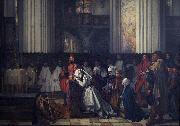 |
Henri Leys -- Click Here
|
|
(18 February 1815 - 26 August 1869), also known as Henri Leys, was a Belgian painter and printmaker.
Henri Leys was born and died in Antwerp. He studied with Mathieu Ignace Van Bree (1773-1839) at the Koninklijke Academie voor Schone Kunsten in Antwerp and then with his brother-in-law Ferdinand De Braekeleer (1792-1883). At the start of his career, he worked with the Belgian Romantic painter Egide Charles Gustave Wappers (1803-1874). Both artists were interested in nationalistic subjects painted in styles that owe much to the example of 16th- and 17th-century Flemish painting. In 1835 Leys went to Paris where he visited the studio of Eugene Delacroix and met Paul Delaroche. During the 1840s, Leys began painting scenes set in 16th-century Antwerp, combining details studied from life with a deliberately archaizing style reminiscent of 16th-century German painters like Albrecht Derer and Quinten Matsys. Some of the pictures have specific historical subjects, but others are genre scenes. With these pictures, he earned a following among many younger artists in Belgium as well as a considerable reputation in France, where he won a gold medal at the International Exhibition in Paris in 1855 for his historical painting The Mass of Berthal de Haze (Royal Museum of Fine Arts, Brussels). In 1862 Leys was created a baron by King Leopold I. At the time of his death, he was engaged in decorating the interior of the Antwerp Town Hall with monumental frescoes depicting the city's history (1863-9). There are easel replicas of these in Brussels. Among the artists who studied with him are James Tissot and Sir Lawrence Alma-Tadema. His best-known pupil is his nephew Henri De Braekeleer (1840-1888).
|
|
|
|
 |
Henri Lehmann -- Click Here
|
|
German Neoclassical Painter, 1814-1882,was a French historical and portrait painter, born in Kiel, Schleswig. He was a pupil of his father, Leo Lehmann, and of Ingres in Paris, where he opened a studio in 1847, after having become naturalized. His brother Rudolf Lehmann was a well-known portrait artist. |
|
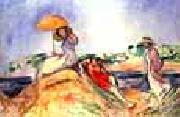 |
Henri Lebasque Prints -- Click Here
|
|
French Painter, 1865-1937
was born in 1865 at Champign?? (Maine-et-Loire). He started his education at the Ecole des Beaux-Arts d??Angers, and moved to Paris in 1886. Here, Lebasque started studying under L??on Bonnat, and assisted Humbert with the decorative murals at the Panth??on. Around this time, Lebasque met Camille Pissarro and Auguste Renoir, who later would have a large impact on his work.
Lebasque's vision was coloured by his contact with younger painters, especially Edouard Vuillard and Pierre Bonnard, founders of the The Nabis' Group and the Intimists who first favoured the calm and quietude of domestic subject matter. From his first acquaintance with Georges Seurat and Paul Signac, Lebasque learnt the significance of a colour theory which stressed the use of complementary colours in shading.
Lebasque was a founding member of the Salon d'Automne in 1903 with his friend Henri Matisse. Two years later a group of artists exhibited there including Georges Rouault, Andr?? Derain, Edouard Vuillard and Henri Matisse while keeping solid links with other artists such as Gustave Rouault, Raoul Dufy, Louis Valtat and especially Henri Manguin, who made him discover the south of France.
His time in South of France would lead to a radical transformation in Lebasque??s paintings, changing his colour palette forever. Other travels included the Vend??e, Normandie and Brittany, although Lebasque would always prefer the small idyllic villages of the South of France.
Lebasque had some commercial success during his lifetime. He worked on the decorations at the theatre of the Champs-Elys??es and of the Transatlantique sealiner.
Lebasque died at Cannet, Alpes Maritimes in 1937.
His work is represented in French museums, notably Angers, Geneva (Petit Palais), Lille (Mus??e des Beaux-Arts), Nantes and Paris (Mus??e d??Orsay) as well as many more around the world. Famed as a painter of 'joy and light', Lebasque is admired for the intimacy of his subject matter and his unique delight in colour and form. |
|
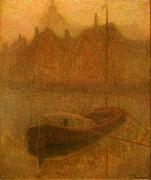 |
Henri Le Sidaner -- Click Here
|
|
(August 7, 1862 - July 1939) was an Intimist painter born to a French family in Port Louis, Mauritius. In 1870 he and his family settled in Dunkirk. Le Sidaner received most of his tutelage from the École des Beaux-Arts under the instruction of Alexandre Cabanel but later broke away due to artistic differences.
He travelled extensively throughout France and also visited many cities around the globe such as London, New York, Venice and Paris as well as some small villages throughout Europe. Le Sidaner exhibited at the Salon, the Galeries Georges Petit in Paris and the Goupil Gallery in London. He lived in Gerberoy, France.
Le Sidaner's work was mentioned in Marcel Proust's novel In Search of Lost Time. In Sodom and Gomorrah, the narrator mentions that an eminent barrister from Paris had devoted his income to collecting the paintings of the "highly distinguished" but "not great" Le Sidaner. |
|
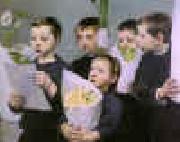 |
Henri Jules Geo -- Click Here
|
|
1853-1924 French Henri Jules Geo Gallery |
|
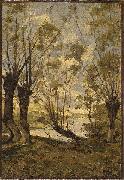 |
Henri Harpignies -- Click Here
|
|
(June 28, 1819 - August 28, 1916) was a French landscape painter of the Barbizon school.
He was born at Valenciennes. His parents intended for him to pursue a business career, but his determination to become an artist was so strong that it conquered all obstacles, and he was allowed at the age of twenty-seven to enter Jean Achard's atelier in Paris. From this painter he acquired a groundwork of sound constructive draughtsmanship, which is so marked a feature of his landscape painting. After two years under this exacting teacher he went to Italy, whence he returned in 1850.
During the next few years he devoted himself to the painting of children in landscape setting, and fell in with Corot and the other Barbizon masters, whose principles and methods are to a certain extent reflected in his own personal art. To Corot he was united by a bond of warm friendship, and the two artists went together to Italy in 1860.
On his return, he scored his first great success at the Salon, in 1861, with his Lisiere de bois sur les bords de l'Allier. After that year he was a regular exhibitor at the old Salon; in 1886 he received his first medal for Le Soir dans la campagne de Rome, which was acquired for the Luxembourg Gallery.
Many of his best works were painted at Herisson in the central France region of Bourbonnais, as well as in the Nivernais and Auvergne regions.
|
|
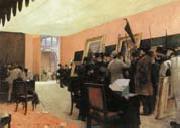 |
Henri Gervex -- Click Here
|
|
French Academic Painter, 1852-1929.French painter. His artistic education began with the Prix de Rome winner Pierre Brisset (1810-90). He then studied under Alexandre Cabanel at the Ecole des Beaux-Arts in Paris, where his fellow pupils included Henri Regnault, Bastien-Lepage, Forain, Humbert (1842-1934) and Cormon; and also informally with Fromentin. Gervexs first Salon picture was a Sleeping Bather (untraced) in 1873: the nude, both in modern and mythological settings, was to remain one of his central artistic preoccupations. In 1876 he painted Autopsy in the H?tel-Dieu (ex-Limoges; untraced), the sort of medical group portrait he repeated in 1887 with his Dr Pean Demonstrating at the Saint-Louis Hospital his Discovery of the Hemostatic Clamp (Paris, Mus. Assist. Pub.), which celebrated the progress of medical science with a sober, quasi-photographic realism. Gervexs most controversial picture was Rolla (1878; Bordeaux, Mus. B.-A.), refused by the Salon of 1878 on grounds of indecency, partly because of the cast-off corset Degas had insisted he include. The painting shows the central character in a de Musset poem, Jacques Rolla, who, having dissipated his family inheritance, casts a final glance at the lovely sleeping form of the prostitute Marion before hurling himself out of the window. As his friend, Manet, had done the year before with his rejected Nana (1877; Hamburg, Ksthalle), Gervex exhibited his work in a commercial gallery, with great success. |
|
|